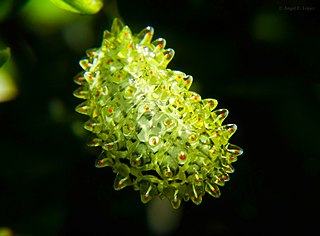Dalcerina tijucana is a moth in the family Dalceridae, and the only species in the genus Dalcerina. It was described by Schaus in 1892. It is found in Panama, eastern Peru, Brazil, Paraguay and northern Argentina. The habitat consists of tropical wet, tropical moist, tropical premontane moist, subtropical wet, subtropical moist, subtropical dry, subtropical lower montane moist and warm temperate moist forests.
Oroya aurora is a moth in the family Dalceridae, and the only species in the genus Oroya. It was described by Miller in 1994. It is found in southern Peru and adjacent Bolivia. The habitat consists of tropical premontane wet, tropical premontane moist and subtropical (lower) montane wet forests.
Acraga goes is a moth of the family Dalceridae. It is found in Costa Rica, Ecuador, Venezuela, Trinidad, Guyana, Surinam, French Guiana, Colombia, Peru and Brazil. The habitat consists of tropical wet, tropical moist, tropical dry, tropical premontane wet, tropical premontane moist and subtropical dry forests.
Acraga andina is a moth of the family Dalceridae. It is found in Andes Mountains of Venezuela, Colombia, Ecuador and Peru. The habitat consists of tropical wet, tropical premontane wet, tropical premontane moist and probably tropical montane wet forests.
Acraga flava is a moth of the family Dalceridae. It is found in southern Brazil and northern Argentina. The habitat consists of tropical premontane moist, subtropical wet, subtropical moist, subtropical lower montane wet, subtropical lower montane moist and warm temperate moist forests.
Acraga neblina is a moth of the family Dalceridae. It is found in Venezuela. The habitat consists of tropical premontane wet and tropical lower montane rain forests, where it is found at high altitudes.

Acraga coa is a moth of the family Dalceridae. It is found in southern Mexico, Belize, Honduras, Guatemala, El Salvador, Costa Rica and Panama. The habitat consists of tropical wet, tropical moist, tropical premontane wet, tropical premontane rain, tropical lower montane moist, subtropical wet, subtropical moist, subtropical dry and warm temperate wet forests.
Acraga concolor is a moth from the family Dalceridae. It is found in Venezuela, Surinam, French Guiana, northern Brazil, Ecuador, Peru and Bolivia. The habitat consists of tropical moist, tropical wet, tropical premontane rain, tropical premontane wet and subtropical moist forests.
Acraga meridensis is a moth of the family Dalceridae. It is found in the Andes Mountains of Venezuela and Colombia. The habitat probably consists of tropical premontane and lower montane moist or wet forests.
Acraga mariala is a moth of the family Dalceridae. It is found in Colombia. The habitat consists of tropical lower montane or premontane wet and tropical lower montane moist forests.
Acraga perbrunnea is a moth of the family Dalceridae. It is found in Colombia and Peru. The habitat consists of tropical lower montane moist and tropical premontane wet forests.
Acraga ampela is a moth in the family Dalceridae. It was described by Herbert Druce in 1890. It is found in Colombia, Peru and Bolivia. The habitat consists of tropical wet, tropical moist, tropical premontane wet and tropical lower montane wet forests.
Acraga ochracea is a moth in the family Dalceridae. It was described by Francis Walker in 1855. It is found in southern Brazil, Paraguay and northern Argentina. The habitat consists of tropical premontane moist, subtropical wet, subtropical moist, subtropical dry and warm temperate moist forests.
Dalcerides alba is a moth in the family Dalceridae. It was described by Herbert Druce in 1887. It is found in southern Mexico, Guatemala, Honduras, Belize, Costa Rica, Panama, Colombia and Ecuador. The habitat consists of tropical wet, tropical moist, tropical dry, tropical lower montane wet or moist, tropical premontane wet, tropical premontane moist, subtropical wet and subtropical moist forests.
Dalcerides sofia is a moth in the family Dalceridae. It was described by Harrison Gray Dyar Jr. in 1910. It is found in southern Mexico, Guatemala, El Salvador, Nicaragua and Costa Rica. The habitat consists of tropical moist, tropical dry, tropical premontane wet, subtropical moist, subtropical dry and warm temperate wet forests.
Dalcerides mesoa is a moth in the family Dalceridae. It was described by Herbert Druce in 1887. It is found in southern Mexico, Guatemala, Costa Rica, Panama, Colombia, Venezuela and Ecuador. The habitat consists of tropical wet, tropical moist, tropical dry, tropical premontane wet, tropical premontane rain, subtropical wet and subtropical dry forests.
Dalcerides flavetta is a moth in the family Dalceridae. It was described by Schaus in 1905. It is found in Venezuela, Guyana, Surinam, French Guiana, Colombia, Ecuador, Peru, Bolivia and northern Brazil. The habitat consists of tropical wet, tropical moist, tropical premontane wet, tropical premontane moist, subtropical moist and tropical dry forests.

Dalcera abrasa is a moth in the family Dalceridae. It is found in Colombia, Venezuela, Guyana, Surinam, French Guiana, Brazil, Peru and Bolivia. The habitat consists of tropical wet, tropical moist, tropical dry, tropical premontane wet, tropical premontane moist, tropical lower montane moist, subtropical moist, subtropical lower montane moist, warm temperate moist and warm temperate dry forests.
Paracraga halophora is a moth in the family Dalceridae. It was described by Harrison Gray Dyar Jr. in 1928. It is found in Brazil and southern Peru. The habitat consists of tropical moist, tropical premontane wet and subtropical wet forests.
Paracraga argentea is a moth in the family Dalceridae. It was described by Schaus in 1910. It is found in Mexico, Honduras, Belize, Guatemala, El Salvador, Costa Rica and Panama. The habitat consists of tropical wet, tropical moist, tropical premontane wet, tropical premontane moist, subtropical wet subtropical moist forests.


